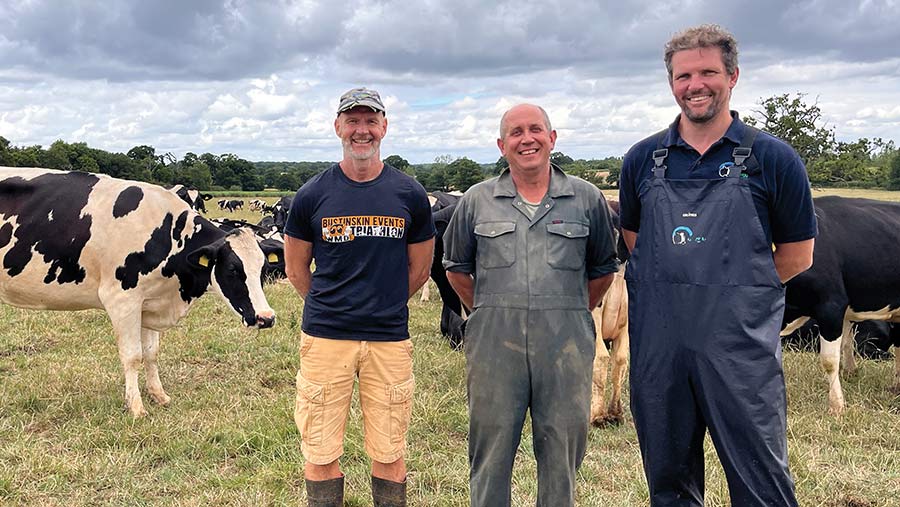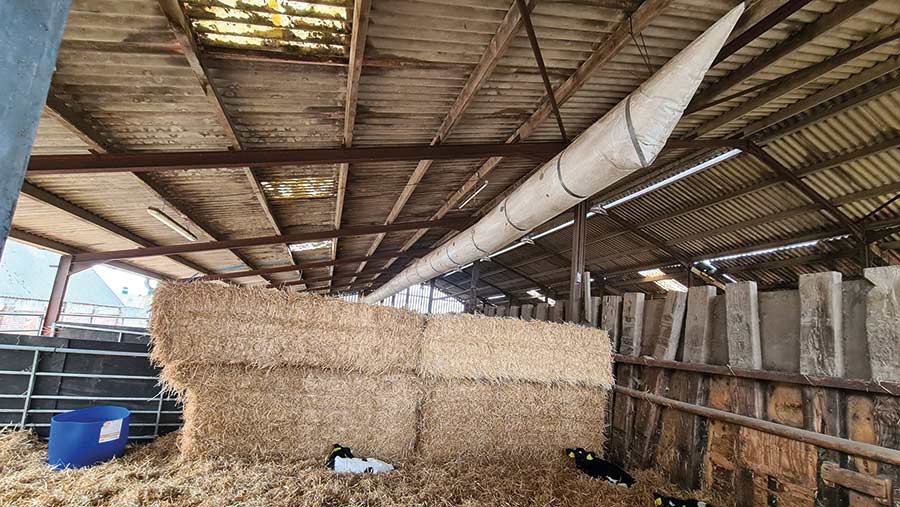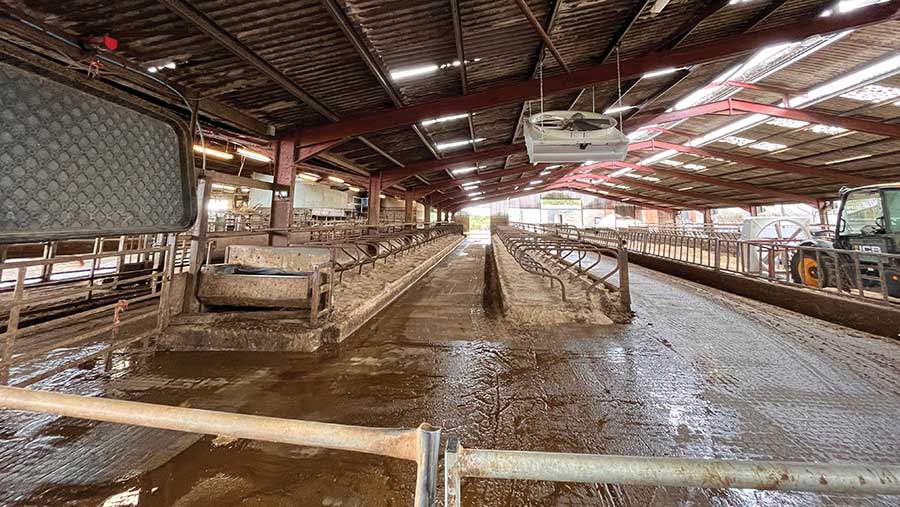How a Dorset dairy farmer cut antibiotics usage by 80%
 Left to right: Gary Jane, James Yeatman and Tom Clarke © Hayley Chapman
Left to right: Gary Jane, James Yeatman and Tom Clarke © Hayley Chapman James Yeatman has cut antibiotics usage in his block-calving dairy herd by 80% in the past eight years, with the main reductions around drying off, mastitis and calf respiratory disease.
Mr Yeatman, who calves 420 cows in Pulham, Dorset, has been fine-tuning his on-farm protocols to avoid using antibiotics unless really necessary.
As a result, use on the farm has fallen from 24.15mg/population corrected unit (PCU) in 2013 to 4.62mg/PCU in 2021.
See also: New livestock Medicine Hub – what it is for and how it can help
This is much lower than the national target set by the Responsible Use of Medicines in Agriculture Alliance (Ruma), for the dairy industry to cut antibiotics use to 21mg/PCU by 2020.
Farm facts: Grange Farm
- Tenanted farm with 162ha (400 acres) split across three blocks and maize grown on contract
- 400-head closed herd of Holstein-Friesians
- Calving from late summer into autumn
- Tesco Sustainable Dairy Group supplier
- Average yield: 10,500 litres at 4% fat and 3.3% protein
- Team of five full-time workers and two part-time milkers
Personal experience has highlighted how valuable antibiotics can be to human health, and this motivates Mr Yeatman to do his part to tackle antimicrobial resistance.
“A family member got Lyme disease about 10 years ago and it got into their nervous system, so they needed intravenous antibiotics every day for three weeks,” he says.
“I also had pneumonia, which just brought home how powerful antibiotics are.
“I think prophylactic use of antibiotics should be frowned upon. If the system relies upon antibiotics, change the system.”
About the same time, herdsman Gary Jane was employed and a partnership with Synergy Farm Health was set up. They collaborated on three health areas to cut antibiotics.
Together, they focused on three areas of cow and calf health to reduce antibiotics use.
1. Dry cow therapy
The herd has gone from 100% of the herd receiving antibiotics as a precautionary measure at drying off to less than 5%.
“When you talk about selective dry cow therapy, people often say ‘good luck’. It’s not luck, it is meticulous procedure followed every single time,” says Mr Yeatman.
Herdsman Mr Jane says he chooses to dry off smaller groups of cows at more frequent intervals rather than doing a big group in one day. This allows him to maintain focus and ensure no step of the process is compromised.
Whether a cow is treated with antibiotics depends on its somatic cell count (SCC) across the lactation period.
If SCC is above 200 at drying off, then Mr Jane will look at whether it has been above 200 previously or frequently during milking. Only if this is the case is treatment given.
Synergy Farm Health vet Tom Clarke says that reducing antibiotics use across the milking herd, especially routine dry cow antibiotics, has the added benefit of not upsetting the biome (natural bacterial population) of the udder.
“This has been shown to leave the cows more resilient to coliform [bacteria found in the environment] mastitis after they have calved,” he says.
2. Mastitis
“We conducted some bacteriology which showed that 60% of the mastitis cases [at Grange Farm] were caused by mild E coli bacteria or showed no [bacterial] growth.
“Research shows that 80% of mild E coli self-cure, so, on that basis, we introduced the team to on-farm cultures.”
Using these cultures, the team can get results within 24 hours and decide whether antibiotics are needed, or non-steroidal anti-inflammatories alone will be sufficient.
Mr Jane says: “When we foremilk, if we discover a cow with clots, we separate the cow, and provided it is not unwell with a temperature or uncomfortable, we will test a milk sample and give her some non-steroidals.”
If the results show gram-negative E coli, the cow will be monitored but not treated with antibiotics unless infection worsens. However, if results present gram-positive bacteria, the cow will be treated with antibiotics.
Some milk samples will also be double-checked by the vet practice’s lab to ensure on-farm tests are accurate.
The current antibiotics treatment rate sits at eight cases for every 100 cows.
“Healthy cows are happy cows, and for me, the fewer antibiotics we need to use, the less hassle there is and the less milk we have to dump,” he says.
Mastitis reduction measures
- Thorough parlour routine with attention to detail on pre-spraying, foremilking, wiping and optimum let-down times
- Changing to vented triangular milking liners to protect teat ends
- Changing from stainless steel to plastic milking cups to reduce weight on teats
- Keeping vacuum rate as low as possible
- Changing from mattresses with light sand to deep sand cubicles

Deep sand is used in cubicles © Hayley Chapman
3. Calf management
“We used to struggle with pneumonia in the calf sheds,” says Mr Yeatman, who would spend £2,500/year on the antibiotic tulathromycin.
Now, having invested the same amount installing ventilation tubes in our calf sheds and improving their colostrum management, the antibiotic is no longer used.
“It was a real positive that came out of questioning our antibiotics use,” he adds.
Tom Shardlow, who works with the farm on youngstock management, says it is about reprioritising vet spend, and investing in preventative measures, rather than firefighting disease.
Having trained in the design of positive pressure tube ventilation (PPTV) systems, he planned a system for the buildings.
He also advised on colostrum management and recommended measures, such as bedding down daily, minimising draughts using plastic sheets, and using straw bale walls to add shelter.
The benefits of the PPTV were seen last year when, after four years with no pneumonia issues, there was an outbreak. It transpired there was a tear in the ventilation system, which meant it was not working effectively.
All calves receive 4-litres of pasteurised colostrum within two hours of birth, and heifers get an additional 2-litres within 12 hours.
Colostrum quality is tested using a Brix refractometer and must be a minimum of 23mg immunoglobulin G (IgG)/ml, but is usually about 25mg lgG/ml.
“Colostrum quality is a good indicator of transition cow management, and if it is low, we will tweak the protein of the cow’s ration,” says Mr Yeatman.
Bespoke PPTV design
Mr Shardlow says it is possible to buy ventilation systems off the shelf, but he believes their design needs to be bespoke to get the most from them.
Important factors include:
- A fan capacity that replaces the total air volume in the shed at least four times an hour
- Holes in the tubes positioned to spread the air evenly over the calves
- Calculation of the air pressure in the tube, so there is even discharge through the holes down the length of the tubes
- Calculation of the air speed from the holes, so that by the time it reaches calf height, it has slowed to a velocity that will not chill the calves.
The above aims are achieved by making sure that the fan capacity, tube diameter, hole numbers, hole positions and hole diameters are all correct for the building.

© James Yeatman
Vet collaboration
Attention is now on making further improvements to the calf sheds to enable easier disinfection, improving transition management and reducing heat stress, especially during summer calving.
This summer, seven 140cm ceiling fans have gone into the cubicle sheds to improve airflow in the worst ventilated areas.
Alongside routine vet visits, the vets hold a pre-calving meeting with all farm staff to run through protocols and an annual review of antibiotics usage.
This review will look into what antibiotics have been used, how the farm benchmarks against other farms of a similar system and how the farm’s use is changing over time.
Mr Yeatman is also using the new Medicine Hub database to record all antibiotics information.
His hope is that more comprehensive data will help the dairy industry improve and demonstrate the progress already made – something he thinks the sector should be proud of.

Ceiling fans improve airflow © Hayley Chapman
